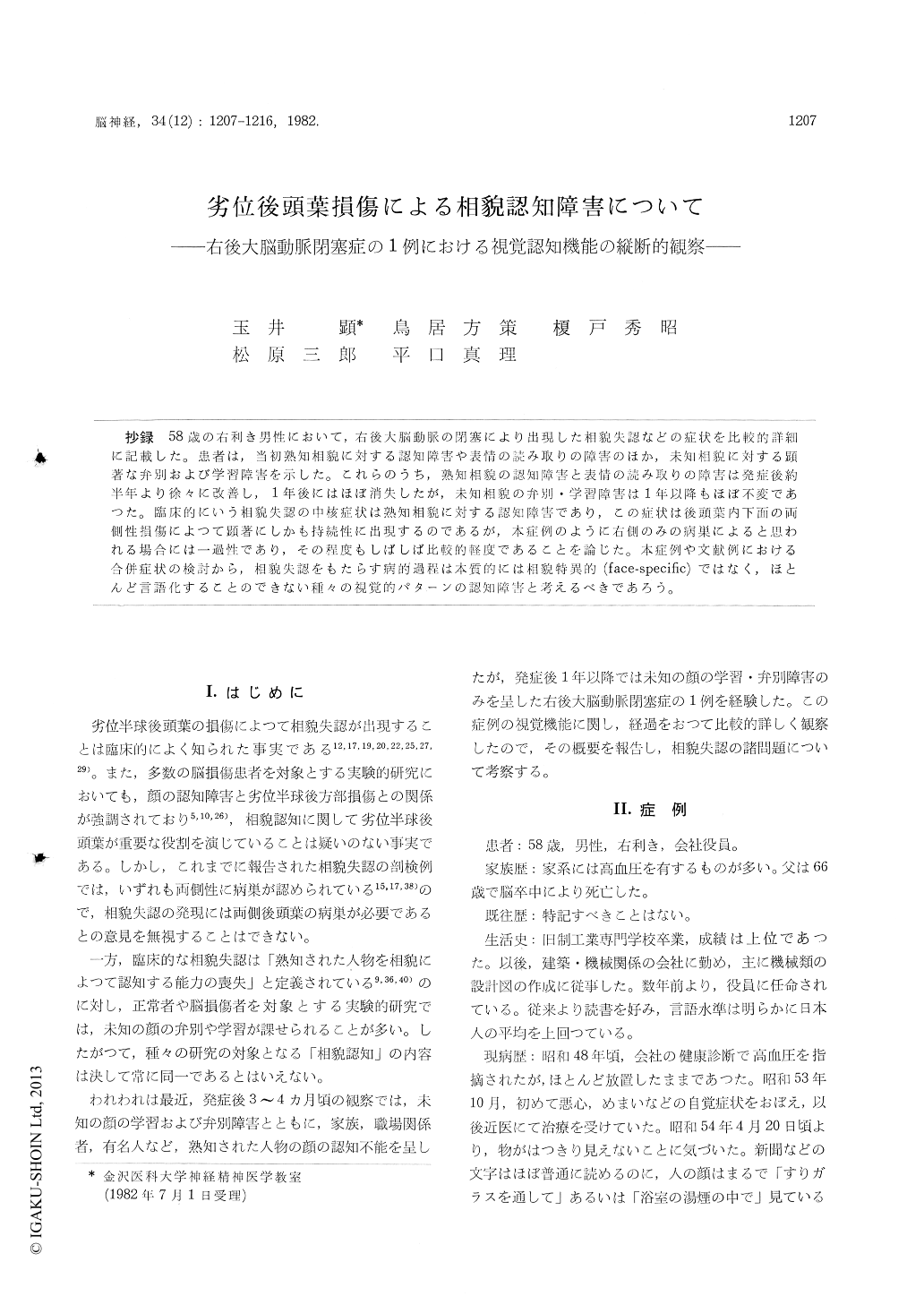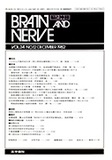Japanese
English
- 有料閲覧
- Abstract 文献概要
- 1ページ目 Look Inside
抄録 58歳の右利き男性こおいて,右後大脳動脈の閉塞により出現した相貌失認などの症状を比較的詳細に記載した。患者は,当初熟知相貌に対する認知障害や表情の読み取りの障害のほか,未知相貌に対する顕著な弁別および学習障害を示した。これらのうち,熟知相貌の認知障害と表情の読み取りの障害は発症後約半年より徐々に改善し,1年後にはほぼ消失したが,未知相貌の弁別・学習障害は1年以降もほぼ不変であつた。臨床的にいう相貌失認の中核症状は熟知相貌に対する認知障害であり,この症状は後頭葉内下面の両側性損傷によつて顕著にしかも持続性に出現するのであるが,本症例のように右側のみの病巣によると思われる場合には一過性であり,その程度もしばしば比較的軽度であることを論じた。本症例や文献例における合併症状の検討から,相貌失認をもたらす病的過程は本質的には相貌特異的(face-specific)ではなく,ほとんど言語化することのできない種々の視覚的パターンの認知障害と考えるべきであろう。
It is a well-known fact that in almost all the cases with prosopagnosia, where autopsy was performed, bilateral posterior cerebral lesions have been revealed, but there are many reports of cases with prosopagnosia which on clinical examinations suggest an occipital lesion only in the non-dominant hemisphere. Furthermore, it was often reported that, on tests concerning unfamiliar faces applied to a number of patients with dif-ferent brain damages, the patients with non-dominant cerebral lesions performed less well than those with dominant cerebral lesions. Thus, it has not been determined whether or not a non-dominant occipital lesion alone is sufficient to produce the clinical symptom called prosopagnosia.
Recently, we observed a patient with occlusion of the right posterior cerebral artery for more than a year. He showed various neuropsychological symptoms including prosopagnosia. We could find several interesting facts about the questions above mentioned
A 58-year-old, right-handed technological desig-ner nocticed, three weeks prior to admission, blurred vision, difficulty in finding his way, and inability to recognize familiar persons without hearing their voices.
On admission a neurological examination reveal-ed only left homonymous hemianopsia. Cranial nerve functions were normal. By CT scan a lowdensity area was found in the right occipital lobe.
His speech and auditory conprehension were quite intact, and he could read and write nor-mally. There were no signs of apraxia. Marked object, or colour, agnosia was not found, but in the domain of visual recognition the patient showed difficulties as follows :
a) Prosopagnosia was found. The patient could not identify his family, friends, or acquaintances by their faces. He could not read facial expres-sions, either. These symptoms were gradually alleviated and were not detected at all about a year after the onset of illness. However, distur-bances of both discrimination and learning of unknown faces which were remarkable on admis-sion were not improved at all more than a year after the onset.
b) The patient could hardly discriminate dif-ferent types of cars or various species of animals. But such animal agnosia was improved relatively rapidly, while disturbed discrimination of car types was almost unchanged
c) He showed difficulty in recognizing mixed figures, dyscopia of complicated Kanji scripts (Chinese ideographic characters), and disturbed performances of the special visuo-spatial tasks for several months after the onset of disease.
d ) There was a mild unilateral spatial inatten-tion for the left visual field.
e) The patient showed the so-called topogra-phical memory loss, since he could not recognize any well-known sight and missed his way very often. Nevertheless, his topographical memory on the map was quite intact, and he read the watch normally. This loss of memory was ameliorated in several months.
The findings in our case together with those in the reported cases, led us to the following con-clusions.
1) The syndromes of prosopagnosia observed in our case consisted of 3 symptoms, namely, agnosia for well-known faces, difficulty in reading facial expressions, and disturbed discrimination and learning of unfamiliar faces. The first two of those symptoms were ameliorated in several months, but the last was observed consistently over a year after the onset of illness.
2) Almost all necropsies with prosopagnosia showed bilateral occipital lesions. In these cases agnosia for well-known faces was always severe and persistent. On the other hand, the symptom was moderate and transitory in the cases of unilateral occipital lesion, such as we observed above. Impairments of discrimination and memory of unknown faces can be produced easily by a non-dominant occipital lesion only, but thosesymptoms should be clearly distinguished from the symptom peculiar to prosopagnosia in the clinical sense, namely agnosia for well-known faces.
3) The survey of symptoms associated with prosopagnosia in the literature has led us to anassumption that the basic disturbance underlying prosopagnosia is not face-specific but seemingly reflecting a general difficulty in discriminating complex visual patterns which cannot be easily verbalized.

Copyright © 1982, Igaku-Shoin Ltd. All rights reserved.


